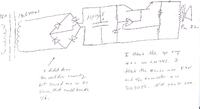obrien135
Full Member level 5
- Joined
- Nov 10, 2009
- Messages
- 240
- Helped
- 5
- Reputation
- 10
- Reaction score
- 5
- Trophy points
- 1,298
- Location
- Connecticut
- Activity points
- 3,259
I built a DC 12V regulated supply using a series pass regulator. I couldn't get a clean DC unless I reduce the output to 12V. I was originally aiming for 17VDC out. The step down transformer had about a 13VRMS output. 13.6V if I remember correctly. So the unfiltered rectified voltage was just under 19VDC. Should I expect less voltage difference between output and input of regulator? Maybe I don't have enough filter capacitance. I used the rule of thumb 3000uF per amp. If I end up stuck with 12V. My question would be why does my CD player have so much more volume at max output, than the power amp that is powerred by the above mentioned power supply, when there is no room in it for a transformer even as big as the one I used. Is there some form of dc conversion that gives the output a higher supply voltage?




